Mad Hedge Biotech and Healthcare Letter
June 30, 2022
Fiat Lux
Featured Trade:
(A SOLID BIOPHARMA WITH A GAMECHANGER UP ITS SLEEVE)
(MRK), (SGEN), (AZN), (ABBV), (BMY)
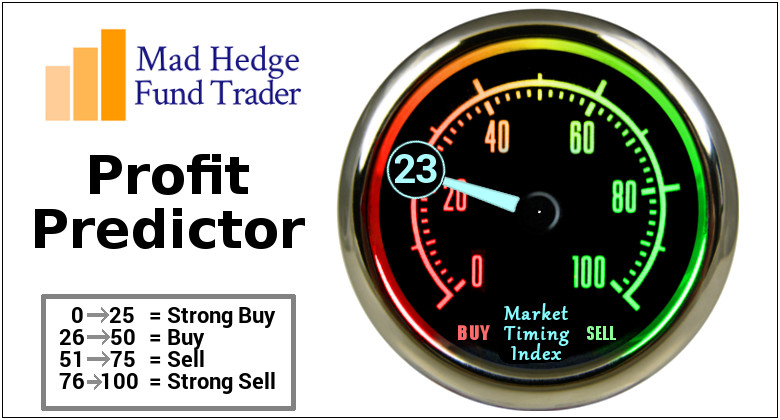
Mad Hedge Biotech and Healthcare Letter
June 30, 2022
Fiat Lux
Featured Trade:
(A SOLID BIOPHARMA WITH A GAMECHANGER UP ITS SLEEVE)
(MRK), (SGEN), (AZN), (ABBV), (BMY)

The mounting uncertainty over fears of a global recession, heightened volatility, and ongoing geopolitical concerns resulted in the decline of the S&P 500 index, pushing it towards a bear market.
In this type of environment, investors can lean on solid dividend stocks to smooth out losses and generate some much-needed passive income.
A great biotechnology and healthcare stock that fits the bill is Merck (MRK).
For one, Merck’s business is solid, rising by 23% year-to-date. The company, with a market capitalization of $233 billion, is the fifth-biggest pharma stock globally.
It develops products for humans and animals, excelling and becoming a frontrunner in both fields.
Among its programs, the most noteworthy is the top-selling cancer drug Keytruda. This product continues to gain more indications despite already having over two dozen regulatory approvals under its belt.
In 2021, Merck launched five blockbuster products. Even its animal health sector posted double-digit growth in net sales for that period.
This also included its COVID-19 antiviral treatment, Lagevrio, which raked in $3.2 billion in sales in the first quarter of 2022 alone.
Merck also has roughly 77 programs queued for Phase 2 trials and 29 more for Phase 3 studies in its pipeline. These cover diverse projects ranging from vaccines, cardiovascular, and diabetes treatments to oncology and endocrinology therapies.
Needless to say, the continuous expansion of the company’s drug portfolio bodes well for its future. Moreover, Merck offers investors a 2.9% dividend yield.
To put that in perspective, 2.9% is about twice the S&P 500’s 1.6% yield.
While Merck is considered one of the top companies in the healthcare industry, reporting almost $50 billion in revenue in 2021, the business has been missing something in the past years: a big growth catalyst.
Despite its solid performance and steady expansion of existing products, Merck’s sales have only increased by roughly 15% from 2019 to 2021.
This might change soon.
Merck has been persistently linked with biotech company Seagen (SGEN) in an effort to bolster its oncology portfolio.
If this plan pushes through, it could be a massive game-changer for both companies.
With a market capitalization of over $32 billion, buying Seagen won’t be cheap for Merck. More than that, other names are supposedly interested in acquiring this company as well. However, it looks like Merck has the best shot at actually sealing the deal.
Growing its revenues impressively over the past 10 years, Seagen is an attractive target for any Big Pharma.
In fact, this biotech has grown from raking in only roughly $200 million in revenue in 2012 to $1.57 billion in 2021. It has also since then expanded its portfolio and broadened its pipeline. This means that the company’s 2027 revenue estimate of $6.9 billion and $10.2 billion by 2031 are within reach.
Seagen would be an excellent fit for Merck because of the overlapping interests of both businesses.
The deal would expand Merck’s oncology footprint, bolster its foothold in the market, and introduce new technology to its pipeline while simultaneously allowing Seagen to inject substantial cash flow to sustain and bring to market its innovative programs.
If this goes through, the deal would be expected to benefit Merck in the same way AstraZeneca (AZN) benefited from Alexion, AbbVie (ABBV) with Allergan, and Bristol-Myers Squibb (BMY) with Celgene.
While it’s risky to speculate on a potential acquisition, Merck remains a good buy regardless of the plans with Seagen.
Considering that the company’s dividend payout ratio is projected to be at 38% in 2022, its dividend seems to be safe and should be able to increase almost as fast as its earnings.
This means Merck could reasonably deliver high-single-digit yearly dividend growth, making it a stock with an excellent combo of income on the side and high growth potential.
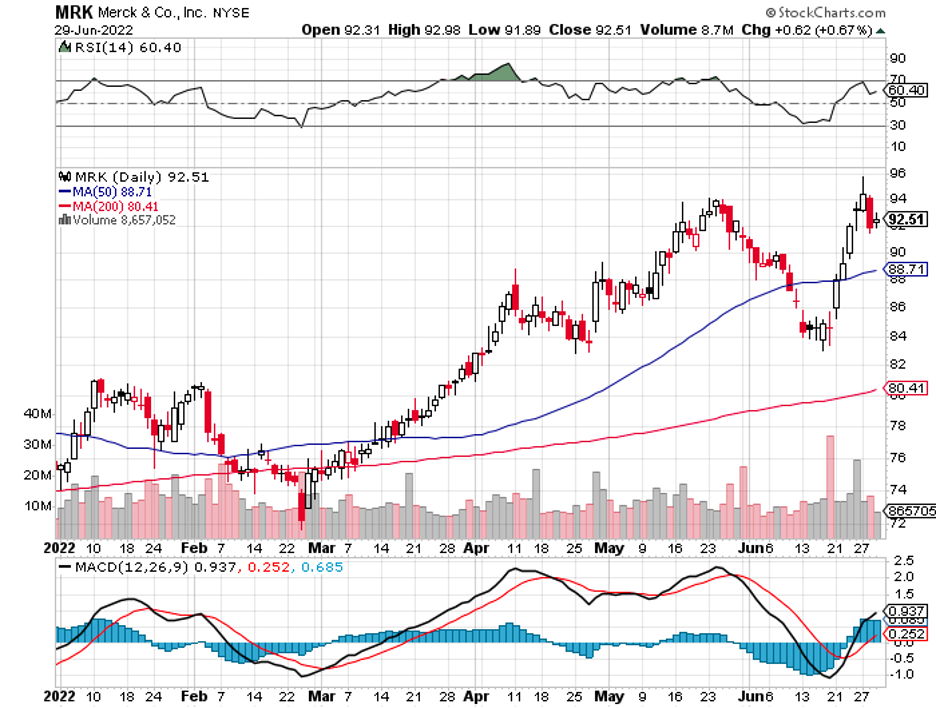
Mad Hedge Biotech and Healthcare Letter
June 28, 2022
Fiat Lux
Featured Trade:
(A RESILIENT BUY-AND-HOLD STOCK)
(AZN), (MRK)
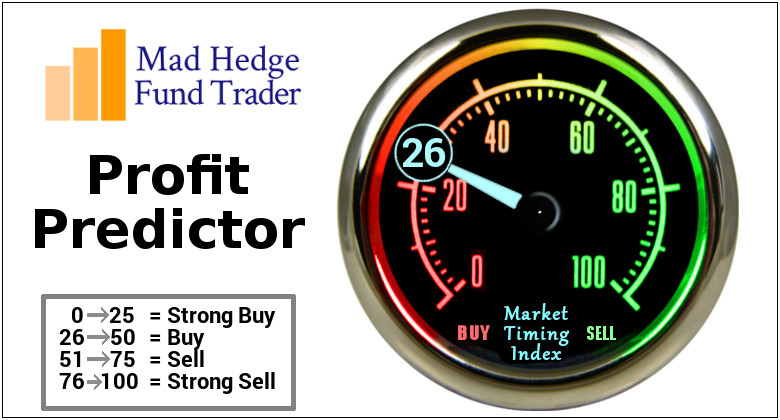
We officially entered a bear market when the S&P 500 continued to decline in value.
Falling by 23% since January, the index has battled constant pressure in 2022 as multiple issues like interest rate hikes and the war in Ukraine continue to make investors anxious over the future of the economy.
While the near-term prospects look gloomy for most businesses, there are several stocks that could be great buy-and-hold investments for the long term.
One of them is AstraZeneca (AZN), which has been in good shape to weather the turbulent conditions and still managed to generate solid results for its shareholders.
A critical factor in making AstraZeneca a top-performing growth stock is the broad range of drugs contributing to its top line.
The company has several blockbusters that generate over $1 billion in yearly revenue to fund its operations.
Needless to say, diversification is critical to appease investors to assure them that they’re not heavily relying on a single product.
Among the products under development for AstraZeneca, one of the most exciting prospects for this year is Enhertu.
Enhertu was just recommended in the European Union as a form of treatment for high-risk breast cancer patients.
This drug, developed with Japan’s Daiichi Sankyo, is anticipated to become another significant growth driver for AstraZeneca.
Breast cancer is the most widely reported type of cancer in the US. It takes over 40,000 lives annually.
Given the latest development and approval for Enhertu, this drug could potentially cover three times as many patients as the existing standard of care.
With the latest endorsement from the EU, Enhertu is estimated to reach $6.6 billion in peak sales. This is $2.5 billion more than the initial projection for this breast cancer treatment.
Aside from Enhertu, the European Union also endorsed Lynparza. This is another AstraZeneca treatment for breast cancer, which it developed jointly with Merck (MRK).
The expansion of its oncology business bodes well for AstraZeneca since it demonstrates a more diverse pipeline.
In 2021, the company acquired a highly sought-after rare disease biotechnology company, Alexion Pharmaceuticals, in an effort to expand its portfolio.
So far, this bet has paid off, with rare disease revenue from Alexion’s programs reaching a total of $1.7 billion in the first quarter of 2022.
To date, this particular segment comprises more than 15% of the total product revenue of AstraZeneca.
Another key strength of AstraZeneca is its strong pipeline and impressive innovation engine, with the company listing over 180 programs queued for development.
The latest developments in its promising programs involve potential breast and liver cancer treatments. In addition to its oncology lineup, the company is also developing new therapies for asthma.
Recently, the company disclosed the creation of a new R&D center in Massachusetts.
The plan is to establish a site for both AstraZeneca and Alexion’s workforces to integrate and work together. That could mean an expanded program for its rare disease portfolio.
In the first quarter of 2022, AstraZeneca’s renal, metabolism, and cardiovascular segments contributed $2.2 billion in sales, showing off a 14% increase from last year’s performance.
Meanwhile, oncology is still the top business of the company, making up 30% of its revenue of roughly $3.4 billion in the first quarter of the year.
Considering that Enhertu is still in its early phase, this number is expected to climb higher in the coming months.
Clearly, AstraZeneca has multiple growth opportunities within reach this year, making it an exciting stock to own.
Moreover, cancer care represents a continuous demand and will not be suspended for reasons like a recession or inflation.
As a leading oncology company, AstraZeneca is a relatively resilient investment despite the uncertainties.
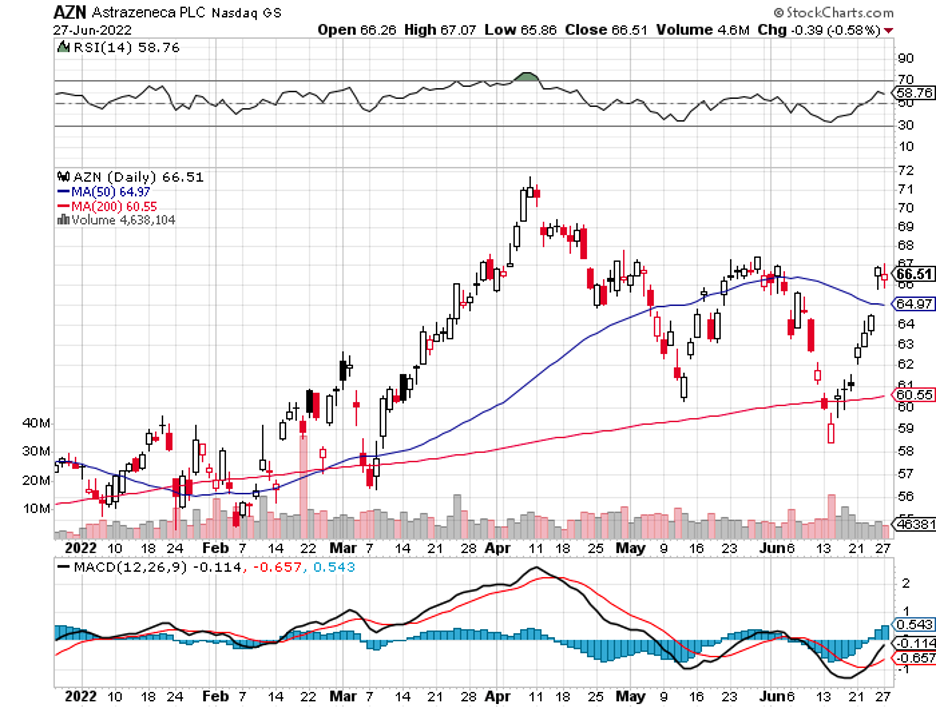
Mad Hedge Biotech and Healthcare Letter
June 23, 2022
Fiat Lux
Featured Trade:
(AN A-RATED STOCK FOR THE ANXIOUS INVESTOR)
(PFE), (AZN), (MRK), (NVO), (BNTX), (VLA), (GSK)

Choosing businesses with size and scale in their favor is more often than not a wise move for investors.
After all, these companies tend to be well established in their respective fields and hold a higher chance than their peers in terms of sticking around for a long time.
Pfizer (PFE) is an excellent example of a mature biopharmaceutical stock that could efficiently deliver great rewards to investors for many years.
However, the elephant in the room for this stock is whether the bumper profits from its COVID-19 vaccines will be sustained in the long term. These concerns have kept a lid regarding the company’s valuation.
If we strip out Comirnaty from the conversation, Pfizer will still have a decent valuation in relation to its share price today.
It has a current P/E of 11x and market capitalization to operating cash flows of 8.9x. In contrast, fellow vaccine maker AstraZeneca (AZN) has been trading at a negative P/E and a stressful market cap to operating cash flow of 27 times.
For added context, Big Pharma names Merck (MRK)’s P/E is 17x while Novo Nordisk (NVO) has been trading 37 times.
Going back to Pfizer, the company’s first-quarter earnings results for 2022 indicated a strong performance and reinforced its guidance this year.
For the full year of 2022, the company projects sales within the range of $98 billion to $102 billion.
To offer you a better picture of the scale of this growth, this would amount to 150% times the yearly sales between 2018 and 2020
It would actually be a quarter higher than the 2019 and 2020 sales combined.
If this roughly $100 billion forecast is achieved, Pfizer will become the first-ever pharmaceutical stock to reach that goal.
To put this in perspective, if we consider Pfizer as a country or a territory, then its GDP would be ranked 64th globally.
This would put it above Ethiopia and immediately behind Puerto Rico.
During this period, Pfizer recorded $25.7 billion in revenue, showing off an impressive 82% operational growth rate year-over-year and a 76% EPS growth.
Comirnaty, co-created with BioNTech (BNTX), raked in $13.2 billion, reporting a 282.1% spike for Pfizer
Meanwhile, the newly launched COVID-19 treatment, Paxlovid, generated $1.5 billion in revenue.
Pfizer’s consistent exponential growth, as shown in the first-quarter earnings, isn’t solely dependent on its COVID vaccines.
While Comirnaty and Paxlovid comprised over 50% of the $25 billion revenue in that period, sales from other segments continued to rise.
For example, stroke and blood clot treatment Eliquis generated $1.8 billion, up by 12% from its 2021 first-quarter sales of $1.2 billion. Meanwhile, heart failure treatment Vyndamax jumped by an impressive 41% to hit $612 million.
On top of its solid drug development pipeline, Pfizer has been leveraging its bumper cash flow to pursue bolt-on acquisitions of promising biopharmas.
Just last month, Pfizer acquired Biohaven Pharmaceuticals for $11.6 billion in cash. The smaller company’s primary treatment is Rimegepant, a migraine medication approved in both the US and Europe.
Aside from that, Pfizer threw its weight behind a fellow COVID vaccine maker, a French biotechnology company called Valneva (VLA).
Valneva’s most promising program is its late-stage development of a vaccine for Lyme disease.
When Pfizer announced its decision to add $95.6 million to the project plus up to $100 million in milestone payments, it triggered a massive 81% surge in Valneva stock price.
Pfizer and Valneva’s partnership for developing a Lyme disease vaccine started in 2020 when the bigger biopharma paid $130 million upfront.
This latest revision of their deal will not only up Pfizer’s stake in Valneva to 8.1% but also allow the French biotech to continue with its Phase 3 trial without the fear of straining its cash position.
Pfizer currently holds a distinct position in its history, with gushers of cash coming practically from all places.
These sums can only be expected to go higher with the anticipated listing of its consumer healthcare business, which it co-owns with GlaxoSmithKline (GSK). While there’s no official word yet on the deal, Pfizer’s plan to sell its stake could generate roughly $19 billion.
Moreover, the company maintains a respectable dividend yield of 3% and a net debt of roughly $10 billion, which can be completely paid off using its operating cashflows for three to four months.
This enables Pfizer to sustain a comfortable credit rating of “A” Stable from Fitch, thereby making it financially stable and safe from the ever-increasing interest rates.
Needless to say, Pfizer is the kind of stock that offers rare stability in this turbulent period.

Mad Hedge Biotech and Healthcare Letter
June 21, 2022
Fiat Lux
Featured Trade:
(A POTENTIAL ONE-STOP-SHOP IN THE CANCER MARKET)
(SEGN), (MRK), (PFE), (ABBV), (JNJ)
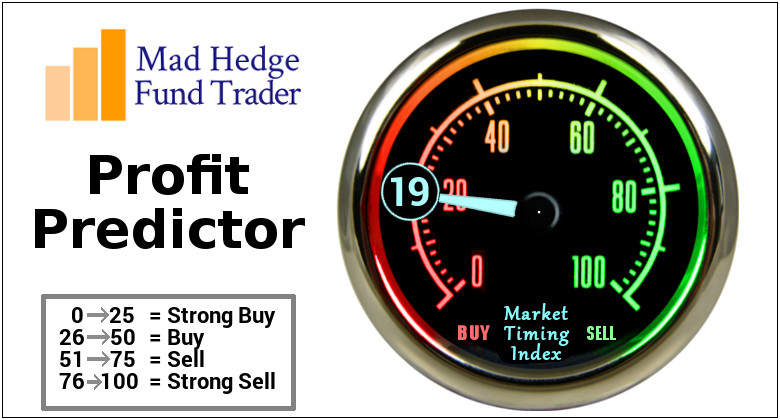
So far, there’s no clear leader in the cancer market. However, it looks like things might change soon if Merck (MRK) gets its way.
The biotechnology and healthcare sector has heard some interesting updates lately involving Merck and its frequent collaborator, Seagen (SEGN).
While Merck already has a stake in Seagen, it appears that the New Jersey biopharma wants the whole thing. There’s no need to panic buy just yet, though, since Merck still has to go through hoops to prove that its plan won’t cause any antitrust issues.
Moreover, Merck won’t be the only suitor. Several names in Big Pharma have been eyeing Seagen for quite some time, including Pfizer (PFE) and AbbVie (ABBV).
Even Japan’s Astellas Pharma, with a jaw-dropping $3.76 trillion market capitalization, is said to be interested.
If this does push through, it would be another massive deal since Seagen’s current market capitalization is at $31 billion.
Why is Seagen an attractive acquisition candidate?
This biotech currently has four cancer treatments available on the market.
It’s also reviewing a couple of candidates to determine how they react as part of a combo therapy with Merck’s blockbuster drug Keytruda.
Evidently, the potential to exclusively own the rights to compounds that could bolster the effects and expand the indications of its bestselling therapy is a significant motivation for Merck.
If the acquisition happens, Merck will undoubtedly be an incredibly formidable powerhouse in the oncology sector.
At the moment, the company already has 46 commercially approved indications in its cancer portfolio.
By 2028, Merck plans to see this number grow to over 80 oncology drugs, with Keytruda leading the charge.
Aside from its potential combination with Merck’s top-selling treatment, what’s more promising for Seagen is its actual portfolio of four molecules or its Big Four franchises.
These are Adcetris, Tukysa, Padcev, and Tivdak.
Adcetris has been hailed as the foundation of care for practically all types of lymphoma, while Padcev has been proven to be the standard of care for advanced bladder cancer.
Tukysa has been hailed as best-in-class for metastatic breast cancer, while Tivdak is the first-in-class for cervical cancer.
Holding such premier titles and indications ensures that these treatments generate highly aggressive revenue boosts, thereby guaranteeing their trajectory towards becoming blockbusters.
After all, you rarely hear of any blockbuster treatment being a second-line therapy.
In terms of sales, the Big Four managed to generate a total of $383 million in the first quarter of 2022. This indicates approximately 27% year-over-year sales growth, which bodes well for the future of Seagen’s portfolio.
Adcetris rakes in $181 million during the said period, Padcev contributed $100 million, Tukysa generated $90 million, and Tivdak recorded $11 million.
Tukysa’s growth was attributed to its penetration of the European market in February 2021, while Adcetris soared because of its expansion to include advanced Hodgkin lymphoma.
As for Tivdak, this particular product’s performance could be attributed to the fact that it was only approved last September 2021.
Among the four, however, Padcev showed the most aggressive rise in sales at a 44% increase year over year.
Its substantial growth is not only due to its superior efficacy over traditional treatments but also to its ever-increasing market penetration.
Aside from the US, it has successfully entered the UK, Japan, Canada, Israel, Switzerland, and the European Union.
Given its history and how it’s performing, Padcev is projected to become a blockbuster treatment before 2030.
Although the Big Four have delivered groundbreaking changes to the oncology sector, Seagen has been consistent in aggressively pursuing new candidates.
It currently has 17 programs in its pipeline, which target blood cancers and solid tumors.
Ultimately, Seagen’s goal is to become an all-around cancer biotech—aka the oncology sector's Johnson & Johnson (JNJ).
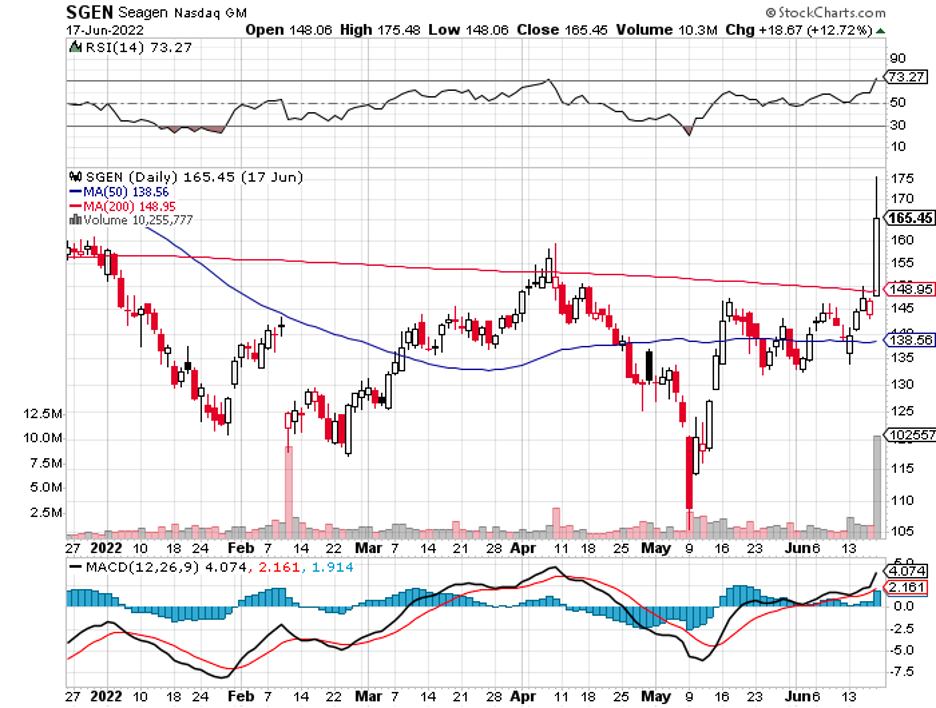
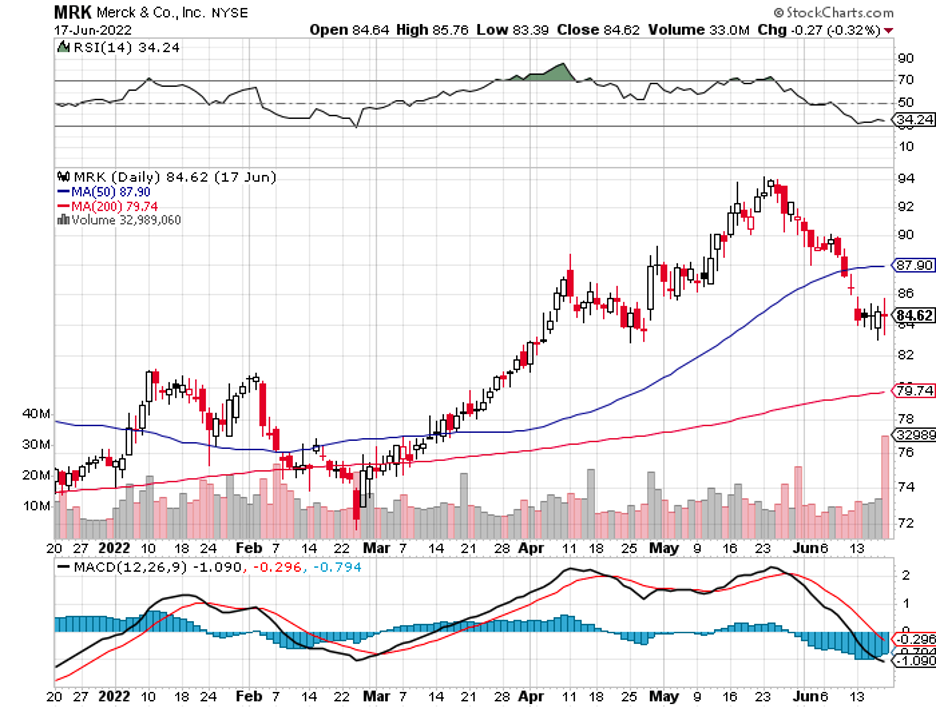
Mad Hedge Biotech and Healthcare Letter
June 16, 2022
Fiat Lux
Featured Trade:
(AN UNDERRATED LONG-TERM BIOPHARMA STOCK)
(OGN), (MRK), (PFE), (VTRS), (ABBV), (JNJ), (AMGN), (RHHBY), (BMY)
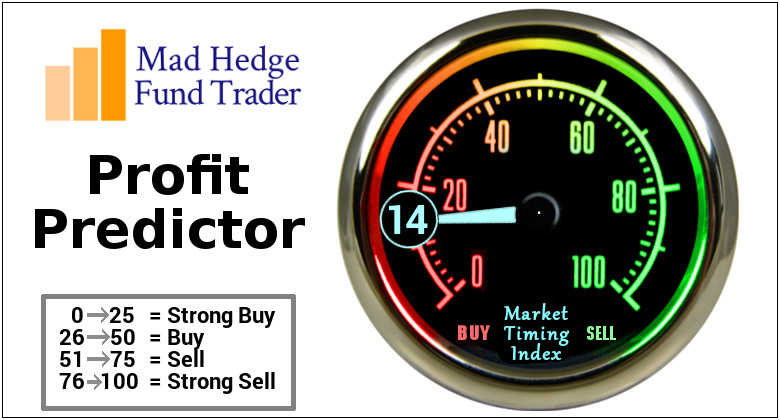
Six months into 2022, the markets are still in turmoil while highly valued stocks rapidly fall.
A way to cope with these is to search for safety and security among value-focused investments that are less at risk of sudden declines.
One business that remains profitable and is trading at a relatively affordable price, especially considering its future earnings multiples, is Organon (OGN).
Organon is a spinoff from Merck (MRK). It focuses on women’s health products, existing treatments, and biosimilars. It was launched roughly the same time Pfizer (PFE) launched its spinoff, Viatris (VTRS), in 2021.
While Organon has yet to become a superstar growth stock at the moment, it’s an excellent business to consider for a stable long-term investment.
So far, the company has managed to generate promising gross margins north of 60% and consistently proved to be profitable.
To date, Organon has over 60 treatments in its pipeline.
Thanks to strategic partnerships, Organon has become the biggest pharmaceutical company centered on women’s health.
Not only that, it has an extensive portfolio of biosimilars or biosimulators focusing on cardiovascular, dermatological, and respiratory conditions.
Meanwhile, Organon has one of the highest dividend yields among biopharma companies at 3.47%, with consistent dividend payments of $0.28 per share every quarter.
Organon’s biosimilar growth received a jumpstart from its agreement with Samsung Boepsis in 2013. The deal enables both companies to develop and market a number of biosimilar treatments focused on cancer and immunology.
Under this partnership, Organon has been granted exclusive license to manufacture, test clinically, and market inflammatory treatments like AbbVie’s (ABBV) top-selling Humira, Johnson & Johnson’s (JNJ) blockbuster Remicade, and Amgen’s (AMGN) moneymaking treatment Enbrel, as well as oncology therapies such as Roche’s (RHHBY) promising growth drivers Avastin and Herceptin.
These catapulted Organon as the leader in the fast-expanding healthcare field, where several lucrative drugs will lose their patent exclusivity before 2030.
Riding this momentum, Organon plans to expand its portfolio of biosimilars to cover more therapeutic fields like neuroscience, diabetes, and even ophthalmology.
To boost its portfolio, Organon has been collaborating with Shanghai’s Henlius Biotech to work on more biosimilars.
The Merck spinoff has agreed to pay $73 million upfront in addition to $30 million in milestone payments for the development of Pertuzumab, a biosimilar for Roche’s breast cancer treatment Perjeta, and Denosumab, a biosimilar of Amgen’s osteoporosis drug Prolia. Another Amgen drug, bone cancer treatment Xgeva, is included in the collaboration agreement.
For context, Amgen reported $873 million in sales for Prolia and $545 million for Xgeva in 2021, while Roche raked in $4 billion from Perjeta.
If this partnership works out, Organon and Henlius plan to move forward with a biosimilar to Bristol Myers Squibb’s (BMY) cancer drug Yervoy and its best-selling Opdivo.
While these are all exciting, it may still take some time for the biosimilars to be released to the market. Among them, the Prolia biosimilar has the most apparent timeline, potentially launching the product by 2024.
Although Organon has yet to make a splash in the biopharmaceutical market, the company holds impressive potential. So far this year, the stock has been up 15%—a performance that’s better than the S&P 500 that recorded 4% in losses over the same period.
More than that, its price is heavily discounted these days, offering investors an extra incentive to seize the opportunity to buy shares of this relatively new company in the healthcare sector.
It also has consistent revenue growth and a promising pipeline of diverse candidates with the potential to expand the company’s portfolio.
Taking all these into consideration makes Organon an underrated buy at the moment and a great candidate for long-term investors.
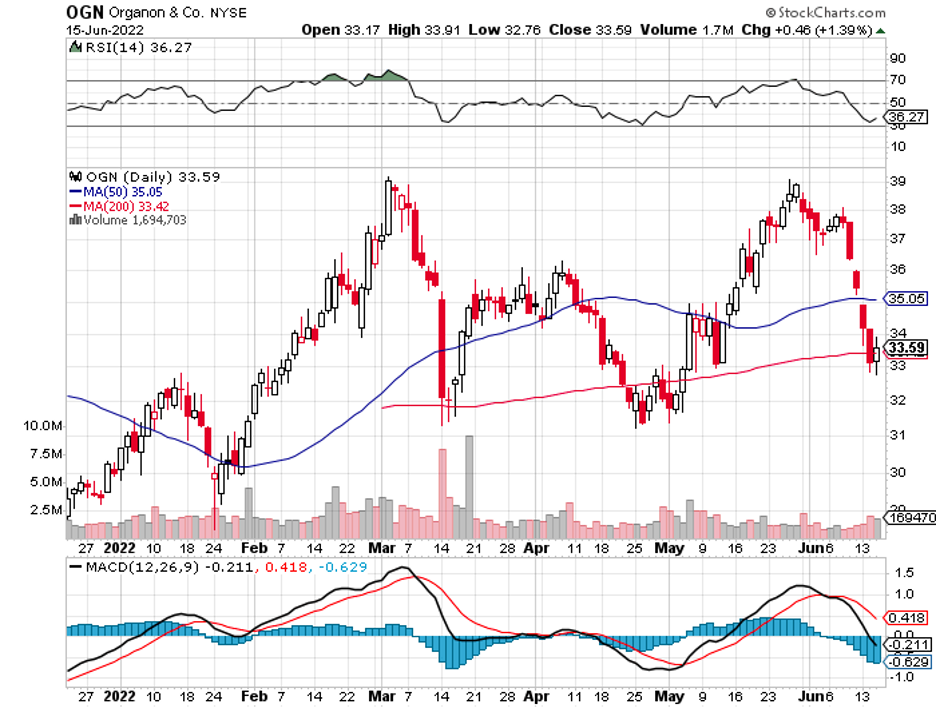
Legal Disclaimer
There is a very high degree of risk involved in trading. Past results are not indicative of future returns. MadHedgeFundTrader.com and all individuals affiliated with this site assume no responsibilities for your trading and investment results. The indicators, strategies, columns, articles and all other features are for educational purposes only and should not be construed as investment advice. Information for futures trading observations are obtained from sources believed to be reliable, but we do not warrant its completeness or accuracy, or warrant any results from the use of the information. Your use of the trading observations is entirely at your own risk and it is your sole responsibility to evaluate the accuracy, completeness and usefulness of the information. You must assess the risk of any trade with your broker and make your own independent decisions regarding any securities mentioned herein. Affiliates of MadHedgeFundTrader.com may have a position or effect transactions in the securities described herein (or options thereon) and/or otherwise employ trading strategies that may be consistent or inconsistent with the provided strategies.
This site uses cookies. By continuing to browse the site, you are agreeing to our use of cookies.
OKLearn moreWe may request cookies to be set on your device. We use cookies to let us know when you visit our websites, how you interact with us, to enrich your user experience, and to customize your relationship with our website.
Click on the different category headings to find out more. You can also change some of your preferences. Note that blocking some types of cookies may impact your experience on our websites and the services we are able to offer.
These cookies are strictly necessary to provide you with services available through our website and to use some of its features.
Because these cookies are strictly necessary to deliver the website, refuseing them will have impact how our site functions. You always can block or delete cookies by changing your browser settings and force blocking all cookies on this website. But this will always prompt you to accept/refuse cookies when revisiting our site.
We fully respect if you want to refuse cookies but to avoid asking you again and again kindly allow us to store a cookie for that. You are free to opt out any time or opt in for other cookies to get a better experience. If you refuse cookies we will remove all set cookies in our domain.
We provide you with a list of stored cookies on your computer in our domain so you can check what we stored. Due to security reasons we are not able to show or modify cookies from other domains. You can check these in your browser security settings.
These cookies collect information that is used either in aggregate form to help us understand how our website is being used or how effective our marketing campaigns are, or to help us customize our website and application for you in order to enhance your experience.
If you do not want that we track your visist to our site you can disable tracking in your browser here:
We also use different external services like Google Webfonts, Google Maps, and external Video providers. Since these providers may collect personal data like your IP address we allow you to block them here. Please be aware that this might heavily reduce the functionality and appearance of our site. Changes will take effect once you reload the page.
Google Webfont Settings:
Google Map Settings:
Vimeo and Youtube video embeds:
